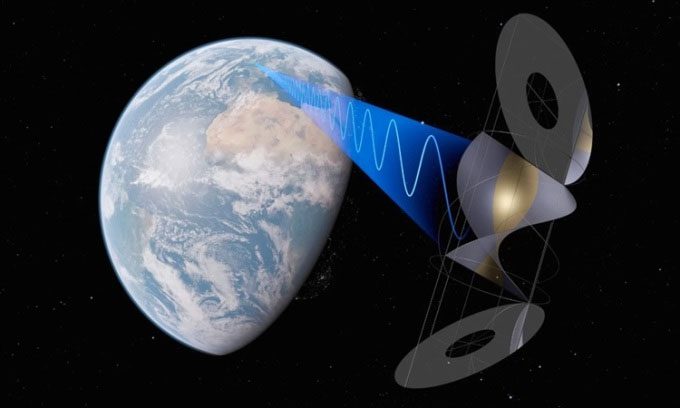Researchers are conducting experiments to produce solar energy in space and transmit it wirelessly to Earth.
Ali Hajimiri, a professor of electrical engineering at the California Institute of Technology (Caltech), has spent a decade researching how to harness solar panels in space and transmit energy back to Earth, according to CNN. This year, Hajimiri and his team took a significant step toward making solar energy production in space a reality. In January 2023, they launched Maple, a 30 cm prototype equipped with a flexible ultra-lightweight transmitter. Their goal is to collect solar energy and transmit it wirelessly in space. The amount of electricity the team harvested was enough to power two LED bulbs.

Simulation of the CASSIOPeiA solar power satellite designed by the UK. (Photo: Space Solar).
However, the researchers’ broader goal is to investigate whether Maple can transmit energy back to Earth. In May 2023, the team decided to conduct an experiment to see what would happen. On a rooftop at Caltech’s Pasadena campus, Hajimiri and several other scientists were able to receive signals from Maple. The energy they detected was too small to be usable, but they achieved a breakthrough in wireless electricity transmission from space.
Producing solar energy in space is not an overly complex idea. Humanity can harness the vast energy of the Sun in space. This is a consistently available power source, unaffected by bad weather, cloud cover, nighttime, or seasons. There are various ideas aimed at achieving this, but the method works as follows: Satellites equipped with solar panels over 1.6 km in diameter would be launched into high orbit. Due to the massive size of these structures, they comprise hundreds of thousands of smaller modules produced en masse, akin to Lego bricks, which would be assembled in space by autonomous robotic machines.
The solar panels on the satellites would capture solar energy, convert it into microwave energy, and transmit it wirelessly back to Earth through a very large signaling device, capable of directing energy to specific locations on the ground with high accuracy. Microwaves can easily penetrate clouds and bad weather, directing toward receiving antennas on Earth. The microwaves would then be converted back into electricity and fed into the power grid.
The receiving antennas, with a diameter of about 6 km, could be built onshore or offshore. Because this grid-like structure is nearly transparent, the land beneath them could be used for solar panels, agriculture, or other activities. A satellite collecting solar energy in space could provide 2 gigawatts of electricity, equivalent to two medium-sized nuclear power plants in the U.S.
A major barrier to this technology is the high costs associated with placing power plants in orbit. Over the last decade, this has begun to change as companies like SpaceX and Blue Origin have started developing reusable rockets. The current launch cost is about $1,500 per kilogram, which is roughly 30 times less than it was during the space shuttle era in the early 1980s.
Proponents of the idea argue that producing solar energy in space could provide for developing countries with high energy demands but lacking infrastructure. This power could also serve many remote towns and villages in the Arctic that are plunged into complete darkness for months each year, and support communities affected by power outages due to natural disasters or conflict.
While there is still a significant gap between the concept and commercialization, governments and companies worldwide believe that solar energy in space could meet the growing demand for clean electricity and help address the climate crisis. In the U.S., the Air Force Research Laboratory plans to launch a small test device named Arachne in 2025. The U.S. Naval Research Laboratory previously launched a module in May 2020 on an experimental orbital vehicle to test solar energy hardware in space conditions. The Chinese Academy of Space Technology aims to launch a solar panel satellite into low Earth orbit by 2028 and into high orbit by 2030.
The UK government conducted an independent study and concluded that producing solar energy in space is technically feasible with designs like CASSIOPeiA, a 1.7 km satellite capable of providing 2 gigawatts of electricity. The European Union is also developing the Solaris program to determine the technical feasibility of solar energy in space.
In California, Hajimiri and his team have spent the past six months testing the prototype’s pressure to gather design data for the next generation. Hajimiri’s ultimate goal is to create a series of lightweight, flexible sails that can be transported, launched, and deployed in space with billions of components operating in perfect synchrony to deliver energy where it is needed.




















































